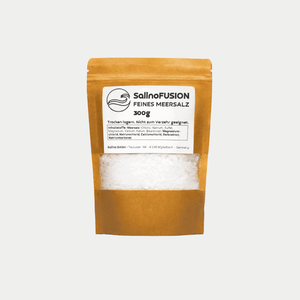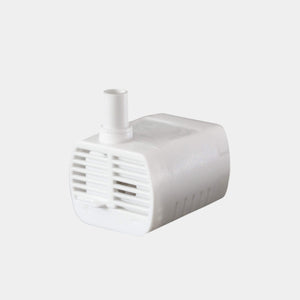It's that early morning moment when you open the door and the first breath of winter air feels like a thousand tiny pinpricks in your lungs. Sharp, clear, almost painful. Your body reacts reflexively: a slight cough, a tightening in your chest, as if something inside you were cramping. What happens in that moment is more than just a momentary irritation. It's the beginning of a silent battle that our respiratory system wages anew every winter – often without us consciously noticing it, until the symptoms can no longer be ignored.
The cold season presents our lungs with challenges that go far beyond what many of us would expect. While we wrap ourselves in thick scarves and protect our skin from the cold, our respiratory tract remains defenseless against the winter air. With every breath, it rushes into us: dry, cold, often laden with pollutants that get trapped in the stagnant air during inversion weather conditions. For healthy people, this is a burden. For those with respiratory diseases, it can become an existential threat.
The invisible threat: What cold does to our respiratory system
When the mucous membranes can no longer fulfill their function
Imagine your airways are a finely tuned system of filters, humidifiers, and heat exchangers. Under normal conditions, this system works perfectly: The mucous membranes in the nose, throat, and bronchi produce a protective mucus that traps pathogens. Tiny hairs, the cilia, transport this mucus, along with the trapped particles, upwards and outwards. The inhaled air is warmed and humidified before it reaches deeper into the lungs.
But winter air disrupts this delicate balance. Cold air can absorb significantly less moisture than warm air—a law of physics that directly impacts our respiratory system. With every breath, moisture is drawn from the mucous membranes. They dry out, become brittle, and lose their suppleness. The protective mucous film becomes thinner, tearing in places. The cilia become stuck together or move only sluggishly.
What follows is a chain reaction: The natural barrier against viruses and bacteria breaks down. Pathogens that would normally be quickly removed now find ideal conditions. They adhere to the irritated mucous membranes, penetrate, and multiply. At the same time, the cold slows blood flow in the fine capillaries of the respiratory tract. Less blood means fewer immune cells that could fight invaders. Thus, the winter air not only weakens the mechanical barrier but also our immunological defenses.
Cold shock: When the bronchi contract

There are people who can barely go outside in winter without their lungs rebelling. Every deep breath of cold air triggers a cough, the chest tightens, and breathing becomes difficult. What feels like an overreaction of the body is actually an ancient protective reflex that has become a problem in the modern world.
When cold air hits the sensitive receptors in the bronchi, the body registers this as a potential threat. The smooth muscles surrounding the airways contract—a reaction originally intended to prevent excessively cold air from reaching deep into the lungs and causing damage. However, in people with asthma, chronic bronchitis, or other respiratory diseases, this reflex can become excessive. The bronchi narrow so much that hardly any air can pass through. A vicious cycle begins: The less air gets through, the more panicky the breathing becomes, the more severe the spasms.
But healthy people also experience this reaction. The stabbing pain when breathing quickly in icy air, the burning sensation when jogging in winter, the feeling of not being able to breathe properly – all these are signs that the cold is putting stress on our respiratory system. Studies show that temperatures below five degrees Celsius are enough to cause measurable changes in lung function. The airways constrict, resistance increases, and breathing becomes less efficient.
Heating air and its hidden dangers
The paradox of warm rooms

We escape the cold into heated rooms, believing we're doing our lungs some good. But what we find there is often no less problematic than the winter air outside. Relative humidity in heated rooms often drops to 20 to 30 percent—levels otherwise only found in deserts. By comparison, we consider humidity between 40 and 60 percent comfortable.
This dry indoor air continues what the cold outside started. Hour after hour, we sit in overheated offices, living rooms, and on public transport, breathing air that continually dehydrates our mucous membranes. The effect is gradual but cumulative. In the morning, our respiratory tract may still feel relatively normal, but as the day progresses, our nose and throat become drier and scratchier. By evening, our voices are hoarse, and the urge to cough is constantly present.
The truly insidious thing about it is that we often don't realize how much this chronic dryness is affecting us. Our bodies get used to the condition, interpreting it as the new normal. Only when a cold strikes—which is more likely to happen in this weakened state—do we realize how damaged our respiratory system already was.
When dust and pollutants have nowhere to go
Dry air in enclosed spaces has another, often overlooked, consequence: It promotes the stirring up and spreading of dust, allergens, and other air pollutants. During the cold season, we ventilate less and for shorter periods. The air in our rooms becomes a stagnant pool, accumulating everything we don't want in our lungs.
Skin flakes, dust mite droppings, mold spores, fumes from furniture and cleaning products, fine dust from candles and cooking processes – all these particles float through the air and land on our already irritated mucous membranes with every breath. The dry, weakened cilia can no longer effectively remove them. This creates a chronic irritation that feels like a faint, never-ending scratchy feeling in the throat, a subtle urge to cough that persists throughout the winter.
For allergy sufferers and people with asthma, the problem is compounded. House dust mites, which thrive in warm, poorly ventilated rooms, become a serious risk factor during the heating season. The combination of dry mucous membranes, reduced immune defenses, and increased allergen exposure can lead to a worsening of symptoms that goes far beyond normal.
The invisible enemy: air pollution in the cold season
Inversion weather conditions: When the air can no longer breathe
There are those winter days when the world seems to be suspended under a cloud. Not a cloud in the sky, bright sunshine, but a gray veil hangs over the city that refuses to lift. What may seem picturesque or mystical is actually one of the most dangerous weather conditions for our respiratory system: a weather inversion.
Normally, the air gets colder with increasing altitude, and warm air masses rise, carrying pollutants with them. With an inversion, the opposite is true: A layer of cold air lies at ground level, with a layer of warmer air above it, like a lid. The air layers can no longer mix, and natural air exchange comes to a standstill. All pollutants produced at ground level—car exhaust, industrial emissions, heating exhaust, particulate matter—collect in this cold air layer near the ground.
Concentrations rise hour by hour, day by day. What we then inhale is a cocktail of particulate matter, nitrogen oxides, sulfur dioxide, and countless other substances that penetrate deep into our lungs. The smallest particles, known as PM2.5 and PM10, are particularly problematic. They reach the alveoli, can cross the blood-air barrier, and trigger inflammatory reactions throughout the body.
The silent inflammation in our lungs
The effects of this winter air pollution are more subtle, but no less dangerous, than acute infections. With every polluted breath, microscopic particles enter the deepest regions of our lungs. These particles settle where gas exchange takes place, where oxygen enters the blood and carbon dioxide is exhaled.
The body recognizes them as foreign bodies and reacts with inflammation. Immune cells are activated, and pro-inflammatory messengers are released. But unlike an infection, which subsides after a few days, this inflammation is chronic. Day after day, winter after winter, new particulate matter accumulates. The inflammation becomes a permanent condition, a smoldering fire that never fully extinguishes.
The consequences aren't immediately apparent. They accumulate over years, even decades. The delicate structures of the lungs are damaged, the tissue loses elasticity, and capacity decreases. For people with pre-existing lung diseases, even a single day of high particulate matter exposure can be enough to trigger a deterioration. Hospital admissions for respiratory illnesses increase measurably during inversion phases. Winter air becomes a health stressor, especially in urban areas.
Strategies for more resilient airways in winter
The art of breathing properly in the cold
It sounds obvious, but the way we breathe determines how well our lungs cope with the winter cold. Most of us instinctively breathe through our mouths in the cold – quickly, shallowly, hectically. That's precisely the mistake. Mouth breathing allows the cold air to flow unfiltered and unheated directly into the bronchi, where it can cause maximum damage.
The nose is our natural air conditioning system. Its intricate structures, well-perfused mucous membranes, and narrow passages—all of this serves to prepare the air we breathe before it penetrates deeper. In the nose, cold air is warmed, moistened, and filtered. By the time it reaches the throat, it is already at almost body temperature. The bronchi are spared the cold shock.
Anyone outdoors in winter should consciously breathe through their nose, even if it seems strange at first. During exercise or brisk walking, a scarf or special breathing mask can help use the warm, moist exhaled air to preheat the air they breathe in. It's a simple trick with a big impact: The bronchi remain relaxed, the mucous membranes are protected, and the risk of infection is reduced.
Moisture from inside and outside
Our mucous membranes need one thing above all else in winter: moisture. We can support them externally by humidifying the air in the room—be it with a humidifier, by placing bowls of water on the radiator, or by simply hanging up damp towels. Even increasing the humidity to 40 to 50 percent can make a noticeable difference.
But hydrating from within is at least as important. Drink, drink, drink – this recommendation sounds trite, but it's essential. Two to three liters of fluids a day is recommended in winter, ideally in the form of warm teas, which also warm from within. Ginger tea, thyme tea, sage tea – many herbs also have anti-inflammatory and expectorant properties.
The mucous membranes can only fulfill their protective function if they are sufficiently moistened. A well-hydrated body produces sufficient mucus, the cilia remain mobile, and pathogens are removed before they can cause damage. It's the simplest and most effective preventative measure we can take.
Exercise in the fresh air – but properly

The temptation to hide in warm rooms in winter is great. But our lungs need exercise, fresh air, and a challenge to stay strong. If you remain physically inactive all winter, your respiratory muscles weaken, your lung capacity decreases, and your entire system becomes sluggish.
The key is the right timing and intensity. On days with high levels of fine dust pollution, which can be checked using warning apps or environmental portals, you should avoid strenuous outdoor physical activity. On clear, windy days, however, when the air is clean, outdoor exercise is ideal. Walking, moderate jogging, cycling – all of these strengthen the respiratory muscles and exercise the lungs.
It's important not to overexert yourself. In temperatures below zero, you should avoid intense endurance exercise or move it indoors. The respiratory system needs time to adjust to the cold. Starting slowly and gradually increasing the intensity gives your body a chance to develop adaptation mechanisms. Over time, the mucous membranes become more resilient, the bronchial tubes become less sensitive, and your entire respiratory physiology adapts.
When the lungs need support
The cold season confronts us with a truth we tend to forget in the summer: Our respiratory tract is vulnerable. It's constantly exposed to the outside world, lacks a protective skin barrier, and has nowhere to hide. Every breath is an encounter with potential threats—be they pathogens, pollutants, or simply the challenge of extreme temperatures.
But we are not helpless in this vulnerability. The better we understand what happens in our lungs when temperatures drop, the more specifically we can support them. It's often the small, everyday decisions that make the difference: Breathe consciously through your nose. Ventilate regularly, even when it's cold. Drink plenty of fluids. Exercise, but do it wisely. Humidify the air. Stay indoors on days with poor air quality or at least avoid strenuous exercise.
For people with chronic respiratory diseases, winter is a particular challenge. They know that any cold can worsen their condition and that every infection takes weeks to truly heal. For them, prevention isn't just a recommendation; it's essential for survival. In addition to the measures mentioned, regular use of inhalations can help keep the airways moist and supplied with blood. Breathing therapies and special breathing techniques, which can be learned from physiotherapists, also make a measurable difference.
Some people also use saline air to support their respiratory system—a principle inspired by spending time at the seaside or in salt caves. Compact devices such as mini-salt baths are now available that distribute saline mist throughout rooms, naturally humidifying the indoor climate and enriching it with minerals. Such aids are not a substitute for medical treatment, but can complement the benefits of keeping mucous membranes more resilient during the long winter months.
The winter air will always challenge us. But with the right knowledge, the right preparation, and a mindful approach to our bodies, we can take on this challenge—and emerge stronger when spring finally arrives and the first warm, moist air flows easily and naturally into our lungs.
(Image source: Envato)



